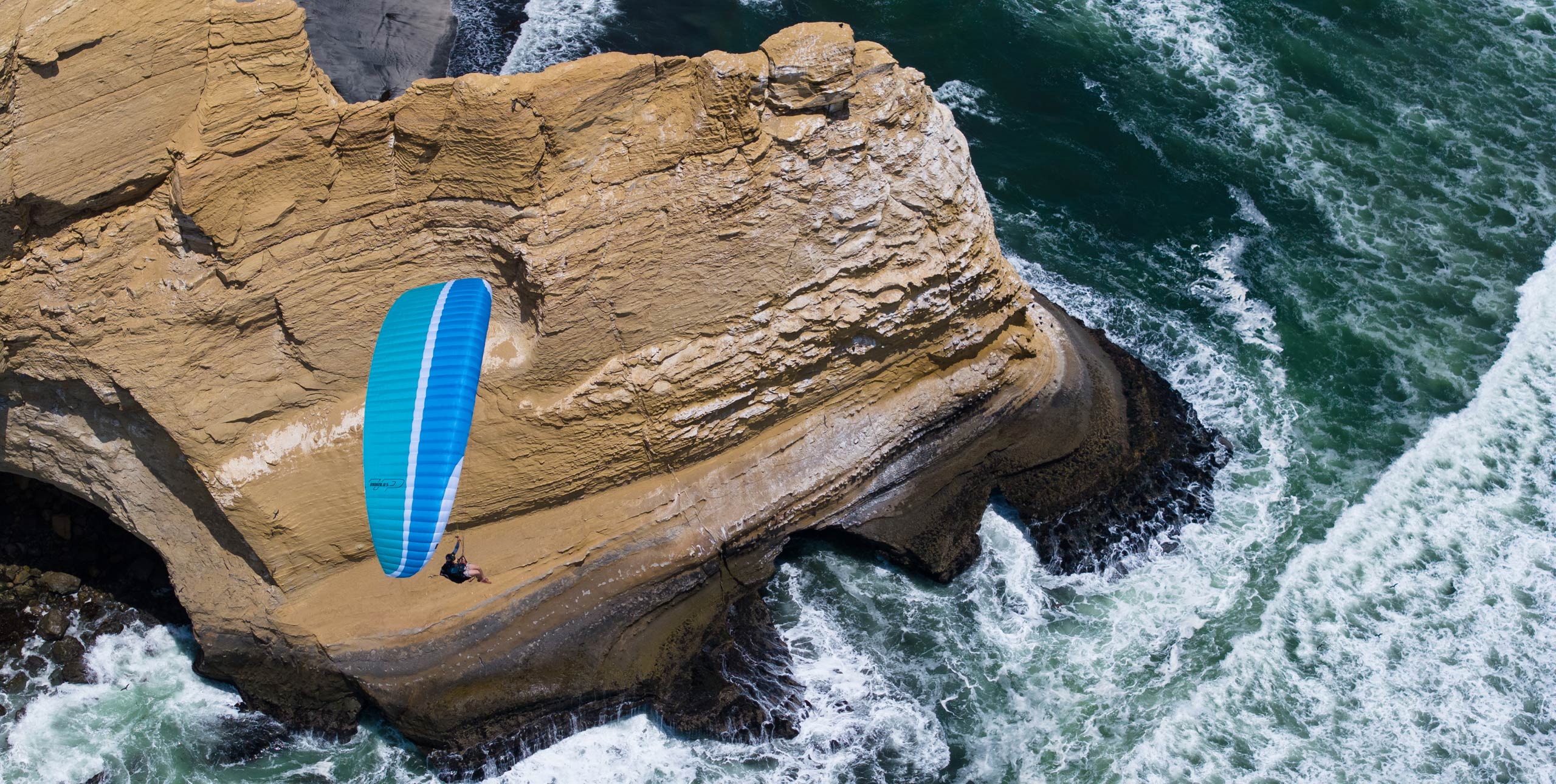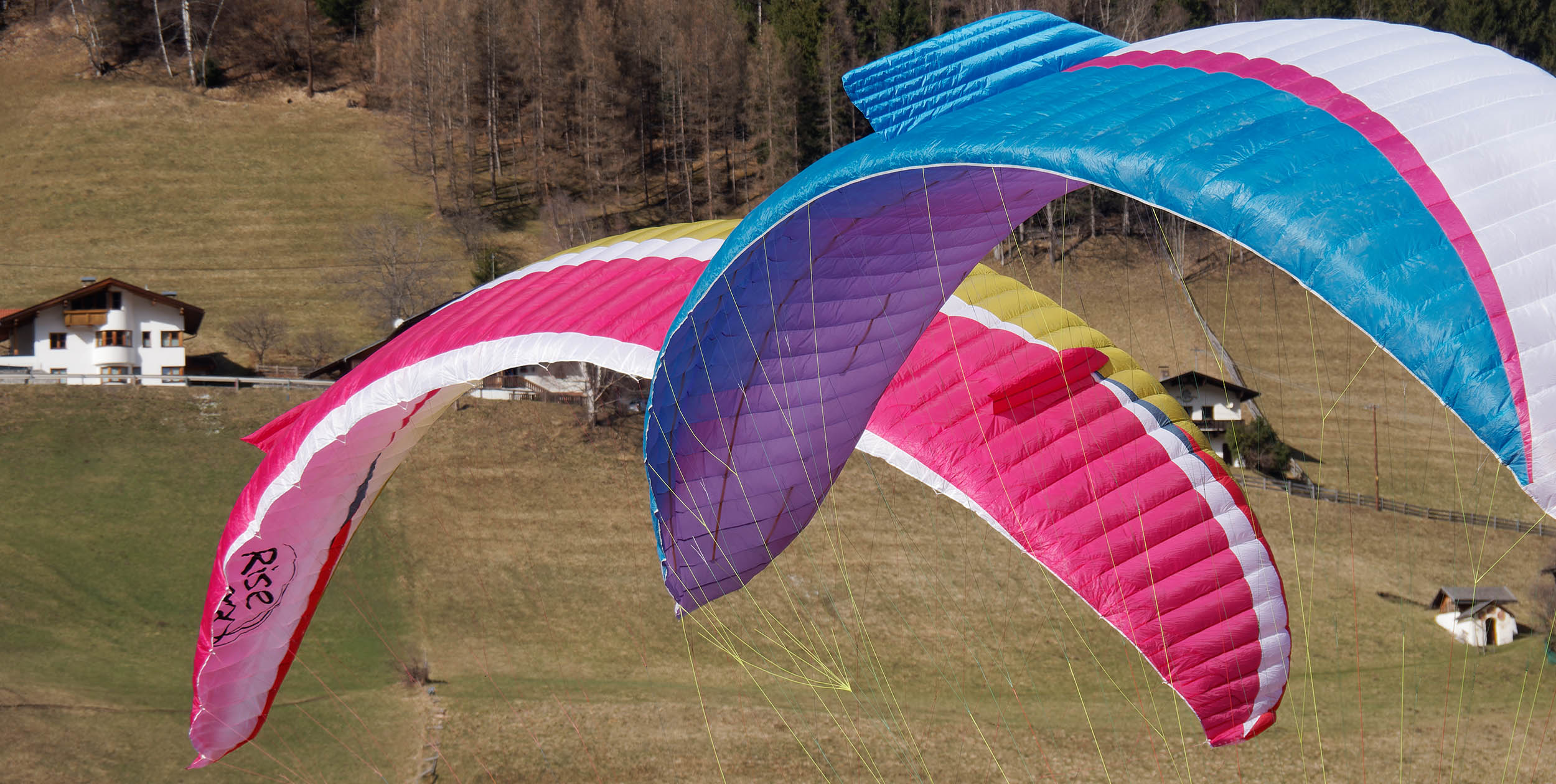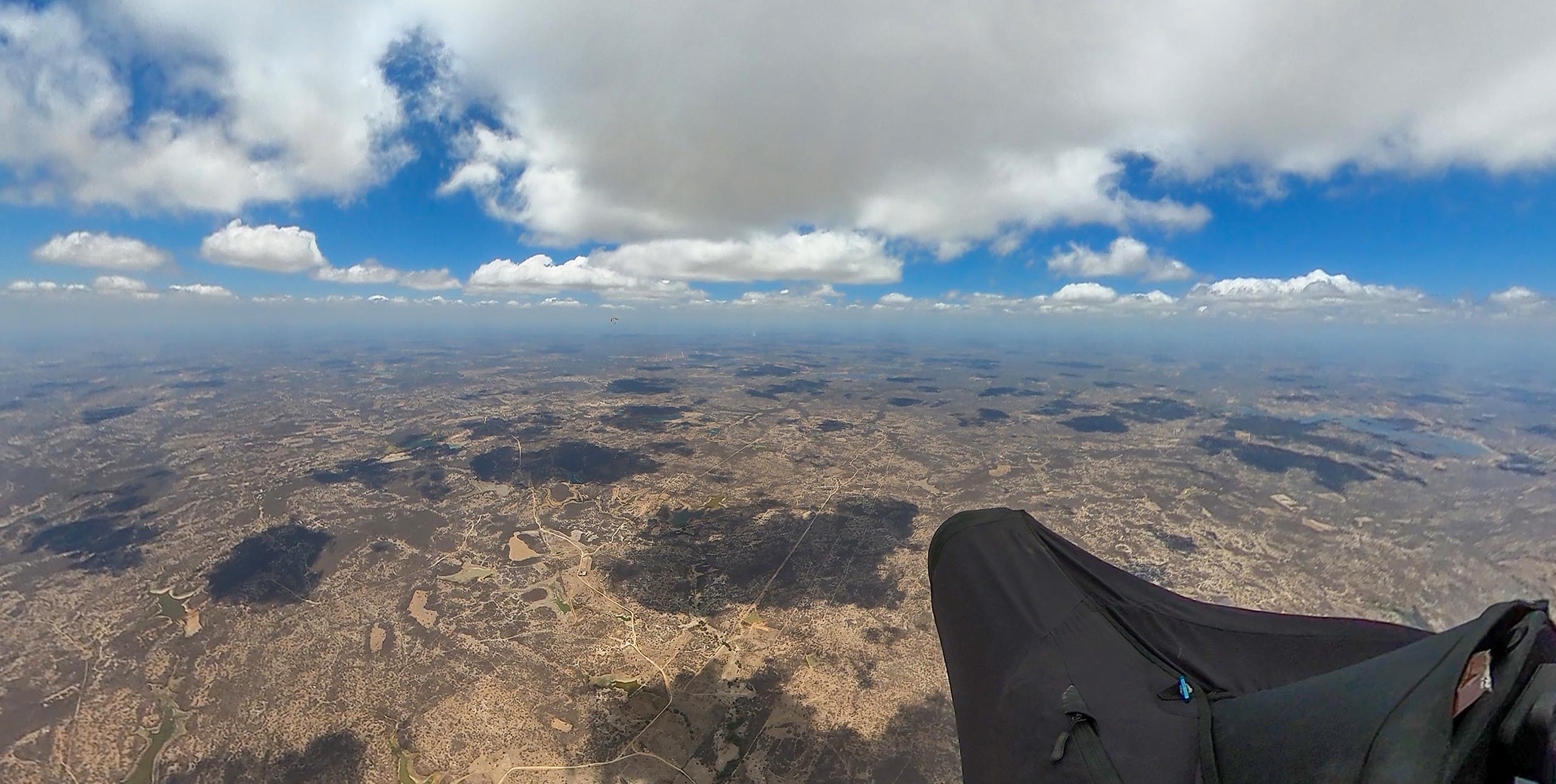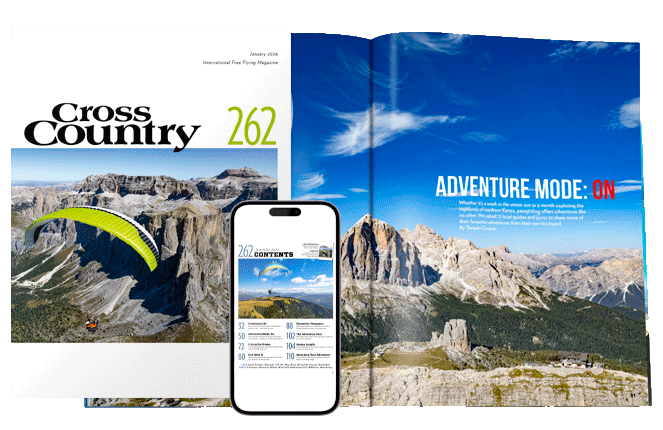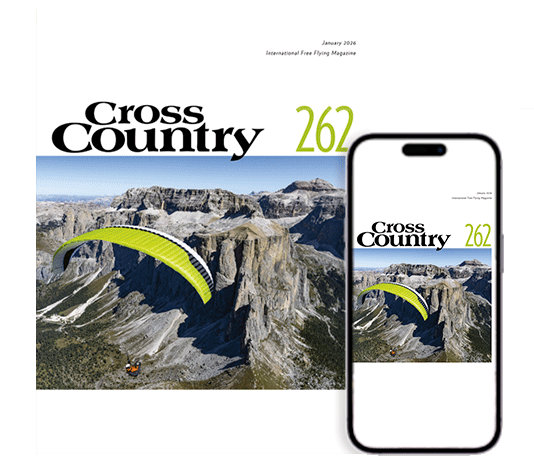Bob Drury reviews the high performance paraglider from UP-Europe. Published in Cross Country magazine in 2001
THE BACKGROUND
UP was one of the early big guns in the flying industry. A Japanese giant with Gin Sok Song as it’s designer, they would have cleaned up in the 1991 Worlds with their UP Flash had they not been denied by Firebird’s necky Ninja. With a competition team featuring the flamboyance and flair of Richard Gallon (FR), the technical and photographic ability of Uli Weiesmeier (D), and the pioneering techniques of Ernst Strobl (D), the early PWC seasons were sewn up by UP.
The company remain a powerful force through the mid-90s, bolstering its competition success with incredibly artistic advertising. But then, in the late-90s, the firm overspent on marketing and appeared to lose its way. In 2000, UP-Europe was bought out by Swedish pilot Christian Ronning who has moved Germany to take an active role in managing the company. UP’s design team is now composed of Torsten Siegel and Stefan Stieglair (1995 World Champ) who carry out the design and testing together.
Torsten, as Fly and Glide’s paraglider reviewer, brings a depth of experience to the team as, when he’s not working for UP, he is out tasting the delights of his competitors wings. Ultralite Products have found their feet again, but is their new focus reflected in their first glider to be released after their resurgence?
THE MACHINE
The Gambit is a sleek elliptically shaped wing with flat rounded tips. It has diagonal cells and internal bracing and carries the looks of a performer even though some of the more recent innovations in paraglider design, such as partly closed cells, are not included.
Torsten told us; “We designed the Gambit as a cross country glider. The profile and shaping are specifically designed to glide well, particularly against the wind, as this is very important in both free flight and competition.”
The colour scheme is straight forward and symmetrical with the wing divided across the span into two halves by a thin black line. The front underside takes the model colour whilst the back half and the entire top surfaces are white. The design is simple, uncluttered and characteristically UP. The wing is now made (and re-certified) using Porcher Marine, after UP encountered supply problems with Carrington. The build quality is excellent.
LAUNCHING
Dead simple. The Gambit is like an intermediate on the ground, and is easier than most other performance gliders to launch in that it does not try and grab you off the ground in strong winds when reverse launching. Forward launches are equally straight forward. I taught a friend of mine – a total beginner to paragliding- to forward launch with the Gambit and he had no problems getting it up first time. Just a light pull on the As is enough to have the wing soaring above your head.
HANDLING
Hugh had flown the Gambit’s predecessor, the Escape, in St Andre in 1997 and had been really impressed by its handling; he said, “it was as if it had power steering and every input resulted in a smooth flowing turn”. However, he didn’t think the Escape’s successor is blessed with such dynamic handling.
We both flew it in a range of conditions and found the UP Gambit predictable and fairly agile throughout. Early flights were made in fairly lumpy air at St Hilaire, surrounded by hordes of Sunday pilots with the odd Eiffel Tower or police car floating past. The Gambit has good roll response and could be steered through the crowds with ease. You can’t flick it round the sky with the ease of a say a Windtech Quarx, but the Gambit does turn flatter in light thermals and will enjoy a slight performance advantage in weak conditions.
Later, we took the Gambit to Monaco, where cloudbase was down at launch and it was a real struggle to stay up. Floating the Gambit around the cliffs was a breeze, with the smallest change in the air’s movement being transmitted down the brakes. It being winter in Europe, I couldn’t tell how the Gambit handles in really big air, but at Gourdon I hit a few punchy cores and found the Gambit likes to move about a bit along its span, always giving loads of feedback.
Wingovers require more weightshift input than some of the tighter handling machines, but are well co-ordinated and easy. All in all, I can’t put my hand on my heart and say it was the most exciting glider I’ve ever flown, yet I have no real criticisms and would be quite happy to own one myself.
PERFORMANCE
Word on the scene has it that UP has a very hot competition glider out this year. Test pilot Stefan Stieglair won the 1995 World Championships on a Pro-Design creation of his own, and is respected for having a talent for tuning gliders with excellent glide at speed, albeit often at the sacrifice of some handling.
Anyhow, don’t be confused by PWC results that list the Gambit up in the top ten, as the comp version is very different from the certified production model. Nevertheless, the Gambit has a fair bit of speed; we recorded 53 km/h flat out and 37 km/h hands up and the glide was very respectable.
Speed bar travel is light enough to be usable all day long and the glider can be accelerated smoothly through the range. I glided against an Octane and an Argon and found only a slight advantage in glide path over the Octane and only a slightly slower top end than the Argon.
SECURITY
The Gambit is a safe and predictable DHV 2-3 wing. Deflations taken in flight were minor and the glider held itself together well. Unlike some wings that feel tense and nervous and have you warily awaiting some major catastrophe that never actually happens, the general feel of the Gambit was one of quiet and serene security.
However, the DHV report speaks of a wing that sits high in the 2-3 category, recording 2-3 results in over half the tests and only scoring a 1-2 for take offs and landings! One has to hope that the secure feeling the Gambit gives to the pilot is because it’s so handy at keeping out of trouble.
The current testing systems don’t account for this, they merely record what happens once the glider has a problem, although it maybe almost impossible to push the glider into that situation. In the case of the Gambit the DHV test pilot suggests that when things do go wrong it would take an experienced pair of hands to keep things in order.
So be aware: despite the Gambit’s gentle nature it is still a high performance aircraft and should be flown by pilots with a sufficient level of skill and experience for that class.
There was also one nagging trait that both Hugh and I picked up on. When exiting symmetrical deflations, Hugh noticed that the Gambit appeared to almost deep stall for a moment and took longer than he expected to get flying again.
I came across this same characteristic on a separate occasion when mushing the glider in to a tight top landing. Most modern wings are quite fast to surge and recover from the stall point and consequently they only drop a metre or so before re-flying, but the Gambit caught me out every time by dropping me 3 or 4 metres before recovering.
Unfortunately the first time it happened the ground met me before the recovery. There is no comment on the DHV report to suggest there is a deep stall issue but I would argue that, whilst not perhaps unsafe, this characteristic will take getting used to.
Aware of the potential problems I could cause UP with the words ‘deep stall’ and ‘unsafe’ in the same sentence I contacted them again to be quite rightly told that the Gambit was specifically designed to glide well, not top land, and that an extra few metres descent from a full frontal is not problem as the glider is still recovering in a safe manner – fair comment, but nevertheless something for the recent or potential buyer to be aware of.
CONCLUSION
The Gambit is a good all-round high performer. It’s not the kind of wing that has you screaming for more but nor is it the kind that has you waking up in a cold sweat, and because of the neutrality of its character it has been a hard glider to review.
It’s safe enough for an active, experienced pilot, and it will reward you with the desired performance of a well tuned 2/3 wing, but, for Hugh and myself, it simply isn’t entertaining enough.
If I had taken it out for dinner, the Gambit would have been a quietly spoken business man in a suit and tie who would engage me in interesting, topical conversation. He would be informative, well educated and diligent. However, what I’m am really looking for is either a hilarious bloke in a loud shirt who’ll crack endless jokes all night before drinking me under the table, or a drop-dead gorgeous girl in a stunning red dress who’d flirt with me till the cows come home.
UP Gambit
Small 65 – 85 kg
Medium 80 – 105kg
Large 95 – 120kg
Specs for the Medium
Area m2 Flat Projected
26 22.4
Span 12.3 10.1
Aspect ratio: 5.8 4.6
Number of Cells: 75
Number of supported ribs: 28
Average line length: 7.19 m
Total Line length: 355 m
Certification: DHV 2-3
• Got news? Send it to us at news@xccontent.local
Subscribe to the world’s favourite hang gliding and paragliding magazine


